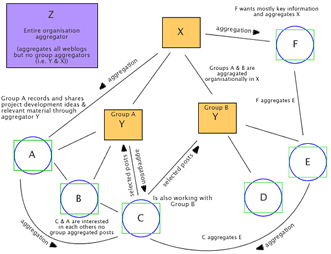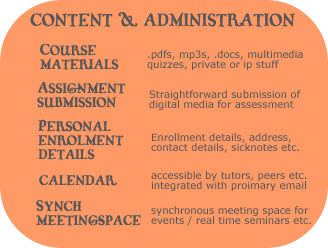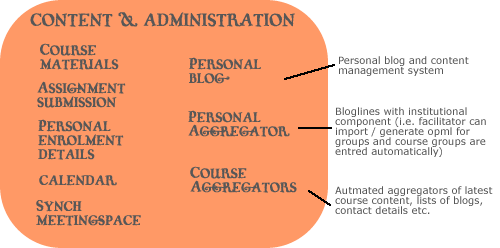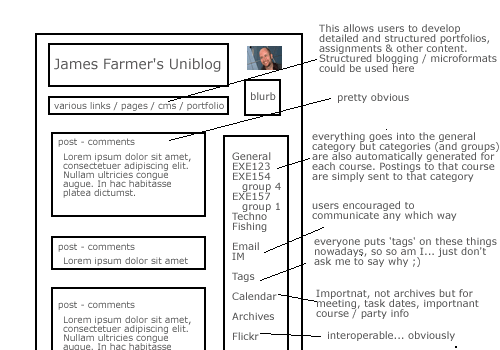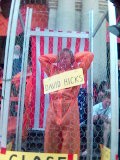Here’s a paper (for review) Anne Bartlett-Bragg & I are submitting to ASCILITE 2005. If you fancy December in Brisbane they’ve just extended the deadline to 22nd July!
Which means, I guess, we can improve on this… with your wonderful feedback :O)
Abstract
Since early 2001 several institutions and many individual teachers have incorporated blogging into their online pedagogical strategies. During this time, weblog (blog) publishing technologies have evolved towards accessibility and ease of use and the technological barriers preventing adoption have dissolved. Blogs and their associated technologies are arguably heralding the most significant technological development in online teaching and learning since the introduction of enterprise level Learning Management Systems (LMS).
This development is all the more significant as a result of the communication dynamics inherent within blog technologies. Whereas an LMS stores and presents all information on a centralised and hierarchical basis, bound within the subject and the organisation, blogs are distributed, aggregated, open and independent. Through the use of blogs, it is suggested that teachers and learners are becoming empowered, motivated, reflective and connected practitioners in new knowledge environments. The balance between individualised and centralised technologies is restored.
The application of weblogs in an education setting will, at best, have a limited impact if due consideration of these developing communication dynamics are ignored. This paper includes a brief review of some of the institutional and individual blog projects that are taking place in higher education. In doing so it examines the different types of blog environments that are being used in terms of their communication dynamics and subsequent impact upon teachers, learners and pedagogy. Further, a more detailed examination is made of the use of blogs in teaching and learning in courses at the University of Technology Sydney (UTS). In light of these studies and examination, possible approaches to implementing blogs in institutional settings are outlined in the form of an alternative Online Learning Environment. In addition, a study to be undertaken in 2006 examining the impact of blogs on teaching and learning at Deakin University will be described.
Introduction – blogs, RSS, email and bulletin boards
The precise details of the history of blogging are not entirely agreed upon, beyond that the medium as we are currently most familiar with began around 1996 and involved the regular posting of ‘items’ in reverse chronological order on a webpage (Blood 2000). It is this visual representation, incorporating other such features as links, comments, taglines, archives, permanent links, blogrolls and more which has largely dominated discussion about the nature of blogs and their potential use.
While these features are extremely significant aspects of what makes up a blog, arguably the most important developments in this area have had little to do with visual representation and form, and much more to do with the facility for the development of individual digital identity and an XML language known as RSS. Through blog technologies now available, individuals are able to simply represent themselves online and as an abbreviation of either ‘RDF Site Summary’ or ‘Really Simple Syndication’, RSS allows users to literally subscribe to a web page and receive complete or summarised new content. This can be done either through an application similar to an email inbox known as a news aggregator or a web based environment most commonly described as a ‘river of news’ aggregator (Winer 2005).
RSS has allowed for the introduction of an entirely new mode of communication and interaction with information artefacts. As, almost without exception in higher education, online asynchronous communication has taken place either through email or discussion boards (Farmer 2004), these aspects are best illustrated by comparison:
Through email, as illustrated in figure 1, control of the communication channel is held entirely by the instigator of the communication. As a result, group email discussion can be characterised at times by flame wars, antisocial behaviour and feelings of intrusion by the participants (Shirky 2004). Further, the information artefact is transitory, unfixed and not archived except in individual instances and as such is of limited value in communication that is meant to facilitate the development extensive consideration or, as Garrison and Anderson (2003) have put it, cognitive presence.
Bulletin boards, as illustrated in figure 2 and deliberately called by their original name rather than the more branded ‘discussion boards’, differ from email perhaps most obviously in that in most cases the user must visit an online area in order to access information. Equally significantly artefacts are now fixed, may be archived in a particular location and are able to be interacted with through threading and comments. As a result, while users are able to refer to, develop upon and interact with artefacts it must happen through deliberately visiting the bulletin area.
RSS, as illustrated in figure 3, differs from email and discussion boards in that users are able to select from where to receive communication and, in most cases, how much of that information that will eventually arrive (summaries, titles, or full entries). Publication of a users own material through RSS allows for the user to communicate only with those that are have selected to aggregate the RSS feed hence giving both parties control over the process. Further, as most RSS aggregators are either integrated with or stand alone desktop / web applications, no requirement is placed on the reader except to check the aggregator for new items.
As a result of these communicative attributes, blogs have been used in educational settings in a number of different roles which have both extended upon and in some instances replaced existing online communication tools. These have included use in an attempt to connect different faculties and communicate more effectively across a diverse university context (Wine, 2003), instead of bulletin boards (Wise 2005), as publication tools for critiques (Cooper & Boddington 2005), as the primary tool for online communication (Gibson 2004) and as independent learning and design journals or ePortfolios (MacColl et al. 2005).
While much has been made of the possible uses of blogs, little examination has taken place of the significant differences in communication dynamics between blogs and other forms on online communication and the impact of these factors on teaching and learning online. This paper seeks to illustrate to a degree that in order to effectively utilize blogs in an educational context, their inherent communication dynamics must be examined and pedagogical and environmental strategies and constructs used which reflect and utilize them effectively.
Different levels of success – some initial experiences with using blogs in education
Though almost all identifiable studies of the use of blogs in education have been relatively positive, there have been significant areas in which no particular difference or negative outcomes have been recorded. In particular, educators have struggled with participation, getting learners to extend themselves in the environment, conducting collaborative tasks using blogs and the challenges of renegotiating ‘private’ reflective tasks into the public arena.
For Krause (2004) the experience of using blogs in a graduate seminar called “Rhetoric and Culture of Cyberspace” made him wonder if:
“it is advisable or even possible to see blogs as a collaborative or especially “interactive” writing environments… I’ve come to believe we shouldn’t substitute blogs for other electronic writing tools that foster discussion and interactive writing, particularly email lists, commonly known as ‘listservs” (Krause 2004)
In this example Krause created three blog spaces for collaborative writing and is frank in his assessment of the lack of success of this experiment which he attributes to the nature of the blogging platform used, a lack of specific requirements expressed in terms of assessment and, most significantly, that participants were instructed to use only the blog platform for electronic communication. He continues to examine this, in particular by referring to “email as discussion space” and “blogs as publishing space” and develops on this further by calling blogs “individualistic” rather than “collaborative”.
Particularly interesting in this case is that when this project was underway the tool used (Blogger, http://blogger.com) did not provide any RSS feeds or categorisation and continues to only provide a competing format, Atom (Wikipedia 2005). Consequently, the blogs existed much more in the form of a bulletin board in their collaborative nature, users had to visit them regularly to communicate and consequently, as Krause quite correctly observes, email would have been a far more beneficial medium for discussion. Further to this, while Krause observes the “individualistic” nature of blogs, each of the three blogs spaces was in fact a shared environment. If one is to conceive of a blog as being ideally suited to the representation of an individual’s digital identity then to create a collaborative instance, as was the case in this instance, for the purposes of communication, is a problematic strategy.
In a similar experience to Krause, Cooper and Boddington (2005) found that their use of blogs, while certainly successful (the mean for their evaluation indicated participants felt quite positively about the experience – 4.53 on a seven point Likert type scale), demonstrated little differentiation between this mode and other forms of online communication.
Their use of group blogs was certainly in a similar fashion to that of Krause (including using the same popular ‘Blogger’ technology) where:
“students were allocated to a blog group (n = 7 to 10 for each group)… [they] were expected to choose one of the case studies provided and post a critique of it onto the group blog (worth 60% of their mark). They then had to post comments on the critique of two peers (worth 20% of their mark for each comment).” (Cooper and Boddington 2005)
While the resulting feedback indicated a degree of satisfaction and no objection to the use of blogs, there was little to indicate any significant shift in student perceptions and activity in the learning environments. While it is beyond the scope of this examination to argue hard and fast rules, this could be attributed, along with other factors such as the nature of assessment, to the use of blogs as collaborative areas without the use of aggregation.
This is a particularly persuasive perspective as studies in which aggregation and the individual use of blogs has been broadly used and focused upon have produced quite different results. For example, Gibson (2004) described his development of a ‘learning blogosphere’ in the University of Michigan’s School of Business as aiming to achieve a “view on what students were learning and where they were encountering problems in a relatively unstructured and technically challenging learning task”. This much more individually focused task notably used the far more flexible Typepad (http://typepad.com) platform and involved extensive aggregation:
“Students used Typepad for their individual blogs. We aggregated students blogs at an aggregation site. The aggregation site published a view of our blogosphere in both XHTML and various XML syndication formats including RSS, atom, and OPML.” (Gibson 2004)
This approach developed through the use of simply a list of sites to a publicly aggregated ‘river of news’ aggregator (Winer 2004) and then finally to the use of individual aggregators which Gibson refers to as “the solution I now recommend as a first option”.
Like Krause and Cooper & Boddington, Gibson also mandated posting and yet while minimal or barely satisfactory posting pattens and participation took place in the former studies, the 31 students in Gibson’s study contributed a stunning 845 posts, many of significant length (2004). Again, while this simply quantitative data is by no means satisfactory evidence of more credible learning it does point to a considerable level of involvement on the part of the participants and engagement with the subject matter and it can consequently be speculated that the significantly different models of individual versus group blogging and aggregation versus no aggregation may have had an impact upon this.
Similarly MacColl et al. (2005), while constrained to a degree on their use of aggregation (their learner blogs were placed behind an institutional firewall and they do not comment on the impact this had on aggregation), focused their blogs on individuals. They mandated posting for a number of different courses yet left significant room for manoeuvre within their assessment guidelines and conclude that “overall we view the introduction of blogs into our studio courses as successful”. This approach of ‘incorporating subversion’ (Farmer 2004) is also much in line with successful individualistic design of online learning environments.
Indeed, for MacColl et al. the individualisation of the blogging experience was significant in that it allowed for the students to express themselves through “heavily customising their blogs and requesting more advanced functionality”. This control over information is, they surmise, critical to “fostering appropriation of the technology for unintended uses” and plays heavily in their future plans to “explore extensions that approximate the fluency of a shared paper-based journal, as a basis for the serendipitous backtalk that reveals unanticipated problems or surprise opportunities”. Invariably, it would seem, aggregation and individualisation would play a key role in this.
Extending the experience – Blogging at UTS
A current research project being conducted within the Faculty of Education at UTS, is investigating the development of knowledge through the use of blogs leading to the formation of personalised collaborative learning networks. All research participants are students in undergraduate degrees studying e-Learning subjects and are required to maintain blogs throughout the entire subject and present their assessment tasks within the body of their blog. The aim of the research is to determine, from the students’ perspective, if the use of blogs to form personalised collaborative learning networks is perceived as enhancing their learning process and the development of knowledge.
The research includes testing a model developed from previous practice (Bartlett-Bragg 2003) and explore the learners’ experiences of identifying and joining a network of integrated communication that extends learning beyond the physical boundaries and opinions of the classroom. The development of knowledge through learning to self-publish and comment on postings that adhere to the protocols and norms of behaviour in the chosen communication network is expected to enhance the learners’ reflective, meta-cognitive and written skills as well as management of their learning. In the context of e-Learning subjects in particular, embedding the use of current technologies into the delivery and assessment of content is considered an essential component of the students’ studies.
The research project intends to foreground the learners’ experience and, using phenomenographic methodology, develop categories of description that are hoped to inform a framework for future application of collaborative learning networks using webpublishing technology. Related literature that will inform the proposed research project is drawn from an integration of multi-disciplinary fields. Theoretical perspectives that will be reviewed and incorporated in a new theoretical framework include:
Vygotsky’s (1978) educational theories that illuminate the development of knowledge construction through the discursive nature of weblogs and have been cited in current weblog research into knowledge management, learning and communication models. Wells (2000) further developed Vygotsky’s work and contributed to the assertion that all learning is socially constructed through language and is in some way collaborative, even when direct human contact is absent. Adapting this theoretical perspective, the new model will emphasise that the key to the collaborative component of learning is a process of inquiry within a social group and the construction of meaning through the exploration within the specific social context.
Bandura’s (1977) Social Learning Theory has the potential to provide an explanation for how weblog networks develop and the manner in which the participants learn the codes of behaviour and acceptable communication formats through observation and modelling.
Lave and Wenger’s (1990) Situated Learning theory will be integrated to conceptualise learning not as a separate and independent activity, but as an integral aspect of participation in a community of practice, thus providing a stronger theoretical rationale for educators to facilitate personalised collaborative learning networks for learners.
Boud (2001) and Schön (1987) provide models of reflective writing processes for learning journals and patterns of behaviours and issues that can be usefully incorporated in a theoretical framework to support writing for publicly published blogs in a collaborative network environment.
The research project is currently in the early stages of data collection and it is too early to report any significant findings. However, early results indicate that the learners’ experience has been challenging, yet positive, with students reporting enhanced levels of understanding of the subjects being studied through the process of publicly writing, researching and participating with others in networks across their blogs. The access to experts and other professionals beyond the boundaries of the classroom environment has been perceived as one of the most valuable aspects of the blog publishing activity. In addition, the ability to categorise and manage the learning content in a personalised manner is apparently an important aspect of the positive experience.
The negative aspects reported, include difficulty with learning new software formats, identifying and establishing networks, feelings of uncertainty in regard to writing publicly and motivation to post regularly.
LMSs & Blogging systems
As a result of and considering these multiple experiences the following blog-based online learning environment is proposed and contrasted with a traditional environment found in most higher educational contexts. At its core the environment highlights individualisation and aggregation and is centred on participants rather than the system or group (Farmer, 2005). It is argued that through this design of the online environment socially constructive and dialogic pedagogical approaches are more effectively put into practice and realised by participants.

In a traditional learning management system communication, content and participants are generally segmented into specific areas such as discussion boards, ‘learning modules’ and synchronous chat environments. Participants are able to communicate in specified areas through bulletin boards and interact with content as separate instances. In essence the participants are focused on the (bulletin-board) communication environments and the presented content.
However, in a blog based Online Learning Environment while content may be accessed from a particular location it is seen to be an integral part of each blogs production through links, commentary and more. Further, communication between participants is centred upon the each individual and facilitated through individual and group aggregation, comments on individual blogs and the use of hyperlinks by the participants.
Rather than segmented areas, courses become clusters of individuals. The capacity for participants to post to multiple categories through particular blogging tools allow then to actively belong to multiple communities and the use of comments, email, voip, instant messaging and other communication tools (frequently integrated into blog structure as alternative means of contact) allow for interaction extended beyond the discussion board area.
Deakin study – blogs across the university
In light of these observations and arguments a study is to take place in Semester 1 of 2006 in Deakin University to investigate the use of blogs as an emerging technology in online teaching and learning. The study will focus on the experiences of 10 teachers evenly split across the five faculties of Deakin implementing blogs in their teaching and learning. It is also hoped that the emancipatory action learning research approach (Kemmis 1993) to be used in the study might indicate better ways to implement APD with emerging technologies.
In each instance, teachers will be provided with designed blog environments based around the groundbreaking blog tools WordPress MultiUser (http://mu.wordpress.org/) and the WordPress plug-in FeedWordPress (link). In each instance every learner will be able to create and maintain their own blog space and will be encouraged to individualise the environment as much as they choose and will be informed that they retain full ownership of the content and environment after the course has finished. Each teaching environment will have it’s own ‘river of news’ aggregator covering all learners and the teacher or that course and learners will also be encouraged to use an individual aggregator with a recommendation of the free tool Bloglines (http://bloglines.com) initially.
Teachers will be supported and be asked to approach the use of blogs from their own pedagogical perspectives. However, use of the tools as individual, aggregated and subvertable areas will be encouraged as will broad and interpretative assessment techniques. Teachers will be encouraged to use, as demonstrated by Gibson (2004), a blog to facilitate, model and engage learners and will also be asked to keep a personal blog, in part to reflect on their experiences within the project.
Conclusion
This paper has aimed to briefly review several different studies of the pedagogy of blogging. It has also outlined studies underway at the University of Technology Sydney and to be undertaken at Deakin University. The paper has been constructed with a particular focus on the analysis of the communication dynamics of blogs and their associated technologies and the impact upon pedagogy and online communication within particular online learning environments. It has attempted to argue that a fuller appreciation of the importance of blogs as individual and aggregated online communication tools within sound pedagogical frameworks can lead to better applications of the technology in teaching and learning in tertiary education.
Having said this, the broad scope and relative reliance upon interpretative study of previous explorations of the area indicates that in many ways this is to a degree a theoretical examination. The results of future research, in particular at Deakin University and the University of Technology Sydney, will do much to clarify and further inform discussion and the increasingly common use of blogs in higher education throughout the world will no doubt add much to the debate. Further research in the area of the impact of aggregation on communication patterns, the development of individual identity through blogs and the different impacts of multiple online communication technologies is appropriate and necessary.
In addition, longitudinal studies , where the practice of learners can be measured and researched across timeframes beyond a single semester, are expected to further provide enhanced frameworks for knowledge development as the learner – author/editor of the web publishing environment – further engages with the opportunities presented by these technologies. In this sense too, the use of RSS, an XML language most closely associated with the semantic web and future developments in internet technology, should provide a degree of ‘future-proofing’ for these developments.
Web publishing technologies are providing educators with radical new opportunities, but simply mixing them within existing institutional paradigms will not be sufficient. Strategies for embracing technologies must not be constrained by currently available or popular options; consideration must be given to future and possible applications of newly emergent technologies as well. A clear commitment to implementing pedagogical strategies that are underpinned by the application of theoretical frameworks and research is to be encouraged if we, as practitioners and researchers, are to fully and responsibly enhance the opportunities presented by the dynamics of personalised, collaborative learning environments. Education may not be a location anymore – it will be an activity – discretely embedded in the lifestyles of our learners.
“If you don’t know where you are going, then it doesn’t matter which road you take, does it?”
Cheshire Cat in Alice in Wonderland.
References
Bartlett-Bragg, A. (2003), Blogging to Learn, The Knowledge Tree, edition 4, December 2003.
Bandura, A. (1977), Social Learning Theory, Prentice Hall, USA
Blood, R. (2000) Weblogs: a history and perspective [viewed 22 June]
Boud, D. (2001), Using journal writing to enhance reflective practice. In English, L.M. and Gillen, M.A. (eds) Promoting Journal Writing in Adult Education, New Directions in Adult and Continuing Education no. 90. San Francisco, Jossey-Bass, pp.9-18
Cooper, C. & Boddington, L. (2005) Assessment by blog: Ethical case studies assessment for an undergraduate business management class Blogtalk Downunder Conference 2005 [viewed 22 June]
Farmer, J. (2004). Communication dynamics: Discussion boards, weblogs and the development of communities of inquiry in online learning environments. In R. Atkinson, C. McBeath, D. Jonas-Dwyer & R. Phillips (Eds), Beyond the comfort zone: Proceedings of the 21st ASCILITE Conference (pp. 274-283). Perth, 5-8 December. [viewed 22 June]
Garrison, R. & Anderson, T. (2003). E-Learning in the 21st Century: A framework for research and practice. Routledge
Gibson, B. (2004) A Learning Blogosphere The Community Engine [viewed 22 June]
Kemmis, S. (1993) Action Research and Social Movement: A Challenge for Policy Research Education Policy Analysis Archives. Vol 1. No. 1 [viewed 20 May 2005]
Krause, S. D. (2004) When Blogging Goes Bad: A Cautionary Tale About Blogs, Email Lists, Discussion, and Interaction Kairos 9.1 9:1 [viewed 22 June]
Lave, J. & Wenger, E. (1990) Situated Learning: Legitimate Peripheral Participation, Cambridge University Press, USA
MacColl, I. Morrison, A. Muhlberger, R. Simpson, M. & Viller, S (2005) Reflections on reflection: Blogging in undergraduate design studios Blogtalk Downunder Conference 2005 [viewed 22 June]
Shirky, C. (2004) Group as User: Flaming and the Design of Social Software “Networks, Economics, and Culture” mailing list November 5, 2004 [viewed 22 June]
Shön, D. A. (1987), Education the Reflective Practitioner, Jossey-Bass, USA
Various Authors (2005) Atom (standard) Wikipedia [viewed 22 June]
Vygotsky, L. (1978), Mind in Society, Harvard University Press, USA
Wells, G. (2000), Dialogic Inquiry in Education: Building on the Legacy of Vygotsky. In Lee, C.D. & Smargorinsky, P. (eds) Vygotskian Perspectives on Literacy Research: Constructing Meaning through Collaborative Inquiry, Cambridge University Press, USA.
Winer, D. (2003) What makes a weblog a weblog? Weblogs @ Harvard May 23rd 2003 [viewed 22 June]
Winer, D. (2005) What is a ‘River of News’ style aggregator? Really Simple Syndication 10 February 2005 [viewed 22 June]
Wise, L. (2005) Blogs versus discussion forums in postgraduate online continuing medical education Blogtalk Downunder Conference 2005 [viewed 22 June]
